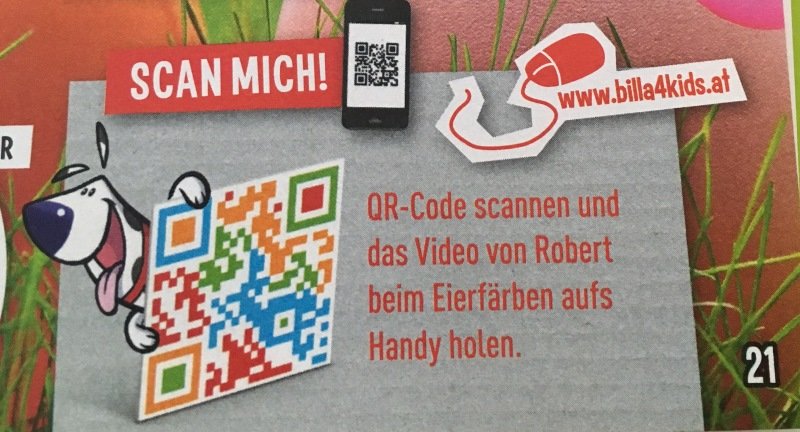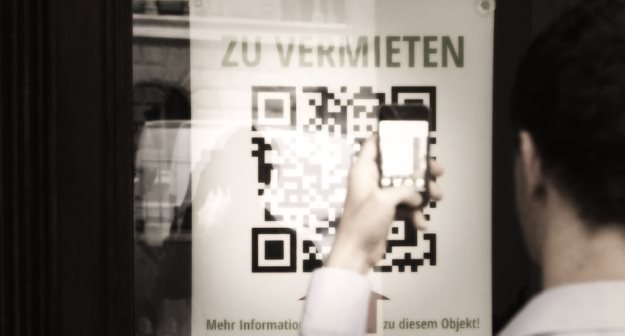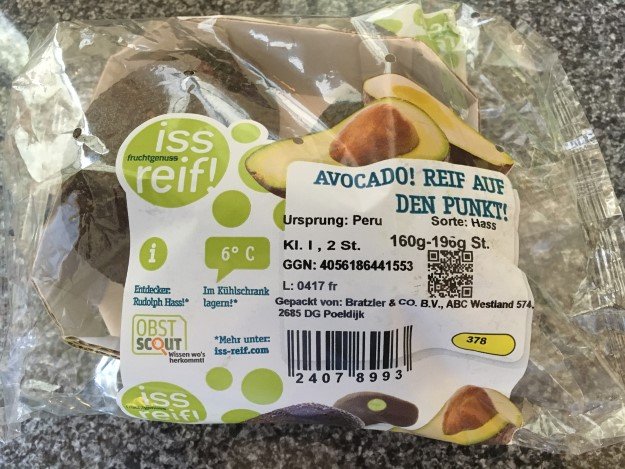When printing a QR Code the following tips will help you to sustain the readability of your QR Code. Nevertheless always do scan tests before printing QR Codes in a high volume.
Tips when creating the QR Code
Provide enough contrast
The color of the QR code should be different enough from the background color, so that the camera is able to decode the QR Code.
 The QR code on the right side differs too little of the background and is hard to be decoded by a QR Code Reader
The QR code on the right side differs too little of the background and is hard to be decoded by a QR Code Reader Mind the quiet zone around the QR Code
Leave enough quiet zone around the QR Code (about 4 blocks). Imagine the quite zone as a frame with the background color of the QR Code around the QR Code. In the example below, white is the background color of the QR Code, so there should be a white frame around the QR Code that is 4 blocks (pixels) wide. If the distance between the pixels of the QR Code and the adjacent graphic elements is too small, the QR Code maybe can not be decoded. Try to scan the right QR code in the following figure. Most QR Code Reader Apps will not be able to decipher the code. Even if, for example, the camera on an iPhone can read the right QR code, that does not mean that this is possible with every smartphone.
 The QR Code on the right might be unreadable since there is no quiet zone around the QR Code
The QR Code on the right might be unreadable since there is no quiet zone around the QR Code Please download the QR Codes in a vector format like .pdf or .svg when printing a QR Code. This ensures that your QR Codes will always stay sharp, no matter which size they have. Other formats like .png may produce a blurred or pixelated outcome when printed. If you insist using the .png format please download the QR Code in a high resolution.
 Use vector QR Code to avoid blurring or pixelation
Use vector QR Code to avoid blurring or pixelation Watch the minimum size
Please be aware of the minimum size of a QR Code. Even if most modern smartphones may read a QR Code with a length less than 5mm this will not be the case for 100% of all phones out there.
 Use a size of 20×20 mm for a QR Code to be readable by any smartphone
Use a size of 20×20 mm for a QR Code to be readable by any smartphone Do not exceed the maximum size of a logo in a QR Code
If you want to embed a logo in a QR code, always use the error correction level H. With that level a maximum area of 30% of the QR code may be overlaid with a logo.
Preferably use squared logos and center them in the QR code. In the margins of a QR code some important pixels are placed which are necessary for the QR Code Reader app to decode the QR Code and therefore they cannot be overwritten. Even if you stick to the maximum size of the logo, please test the QR Code with multiple QR Code Reader apps for readability. If the QR code cannot be decoded, reduce the size or change the aspect ratio of the logo. The safest version, however, is still a purely black and white QR code.
 A maximum of 30% of the QR code can be overwritten with a logo so that it still be readable
A maximum of 30% of the QR code can be overwritten with a logo so that it still be readable Beware of Inverted (Negative) QR Codes
Sometimes a QR Code is better suited to an illustration, if the colors are chosen inversely. That means, that the black pixels of the QR Code are colored white and the background is kept in a dark color. In principle, such inverse or negative QR Codes can be decoded by various QR Code Readers, nevertheless with caution. The QR Code on the right side in the figure could was unreadable for 2 out of 5 tested QR Code readers apps. However, the iPhone native camera app can read inverted QR Codes.
 Not all QR Code Readers are able to decode inverted QR Codes like shown on the right
Not all QR Code Readers are able to decode inverted QR Codes like shown on the right Avoid excessive distortion and 3D effects
In the following example, Billa's marketing team has unfortunately "failed" the QR code campaign. Two QR codes that don't work, one too small and filled with meaningless information, the other so badly tilted and distorted that it can no longer be read. A simple pre-production scan test would have sufficed to stop and correct the printing of this campaign.
 The tilting effect and the dog's paw in the critical area of the QR code make the code unreadable.
The tilting effect and the dog's paw in the critical area of the QR code make the code unreadable.Use Dynamic QR Codes!
 A dynamic QR code allows the target URL to be changed even after printing
A dynamic QR code allows the target URL to be changed even after printingWhen you have printed QR Codes on thousands of flyers, posters or in magazines, the worst thing is to find out, that the QR Code redirects to a broken website. In case you have used dynamic QR Codes, you can change the target URL anytime without printing the QR Codes again. To save your budget and nerves: Avoid static QR Codes in your campaigns and always test your QR Codes before going in production!
Tips for print materials
Avoid reflective surfaces
 If reflections occur, the QR code cannot be read
If reflections occur, the QR code cannot be readNote especially that when a QR code is affixed behind a glass, reflections may occur, so that the camera can have problems when decoding the QR Code. Print the QR Code beforehand, mount the code at the place where it will be in production and do scanning tests to ensure readability.
Stay away from materials that crease easily
 Wrinkled QR Codes reduce readability
Wrinkled QR Codes reduce readabilityThe QR Code printed on the product packaging is difficult to read if the packaging material is slightly wrinkled or uneven.
Do not print on objects with excessive curvature
 If the curvature is too great, the QR Code will become unreadable
If the curvature is too great, the QR Code will become unreadable Also note the curvature of the medium on which the QR code is printed. If a QR code is applied to packaging such as a can or a tube of toothpaste, it can no longer be read if it is too curved.
If the medium can be easily wrinkled or distorted (e.g. QR code as a tattoo or on clothing), caution is also required.
Beware printing QR Codes on moving objects (e.g. cars)
We do not recommend you to print QR Codes on moving objects such as cars, buses, trucks, trams, etc. Nobody can scan a QR Code if the object is moving. It also poses a traffic hazard if the person scanning is distracted from what is happening. It's also the other way around, so nobody scans a QR code when someone walks past a parked car. Print QR Codes on flyers, in brochures on product packaging or on business cards, this is where the highest scan rates are achieved.